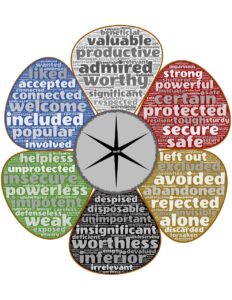TL;DR:
– Secure attachment is a foundation for healthy relationships, rooted in trust and emotional connection.
– Importance of secure attachment is evident in personal well-being and the dynamics of various relationships.
– Recognizing Signs of Secure Attachment helps in understanding and nourishing healthy connections.
– Developing Secure Attachment involves intentional strategies for both children and adults to enhance relationship quality.
– Lack of Secure Attachment can lead to mental health challenges and strained interpersonal bonds, necessitating coping mechanisms.
Introduction
Secure attachment is the cornerstone of a healthy relationship, playing a pivotal role in our emotional well-being. Through my years of experience as a relationships advisor and a self-improvement expert, I’ve seen the remarkable impact secure-attachment can have. In this article, we’ll uncover 5 potent strategies to promote this kind of emotional bond, building resilience and enhancing our relationships. So, let’s embark on this enriching journey and learn to foster a deeper connection with ourselves and others around us. So, are you ready to nurture your relationships with these powerful steps towards secure-attachment?
What is Secure Attachment?
Secure-attachment, a concept prevalent within relationships and child development, centers around an individual’s innate need to establish strong emotional ties. In this context, secure-attachment refers to a trusting, predictable, and safe emotional connection between two individuals, be it a parent-child or romantic relationship.
Understanding the Concept of Secure Attachment
Secure-attachment is a relational concept that manifests as a deep emotional bonding enabling individuals to use their trusted partners as a secure base. That is, when faced with life’s challenges, individuals with a secure-attachment style turn to their partners for comfort and security. As VeryWell Mind explains, the bond fosters emotional wellness, enabling individuals to explore their environments without fear.
Roots of Secure Attachment: Background and Theory
Secure-attachment’s theory originates from psychologist John Bowlby’s attachment theory, positing that humans have an inherent desire to create deep, emotional bonds. Our early attachments, specifically those formed during infancy, drastically inform our future attachments and interactions. For more comprehensive understanding, read about the original attachment theory on Simply Psychology.
Types of Secure Attachment
Following Bowlby’s groundwork was Mary Ainsworth, who identified distinct types of attachment: secure attachment, anxious-resistant attachment, anxious-avoidant attachment, and disorganized attachment. Under secure-attachment, individuals feel safe, and their emotional needs are consistently met, fostering positive expectations of relationships in their later life stages.
Why is Secure Attachment Important?
Secure-attachment is a critical component to fostering healthy psychological development and maintaining stable relationships. But why exactly is it essential? Our sense of safety, self-esteem, and capacity to develop meaningful relationships are all influenced by our attachment style, making it a fundamental aspect of our lives.
Role of Secure Attachment in our personal lives
Secure-attachment can significantly impact our personal life. It not only influences our ability to trust and communicate effectively, but also our self-esteem and emotional health. When we are confident about our bonds with caregivers or partners, we are more likely to have a positive view of ourselves and trust in our capabilities. Developing secure-attachment provides us with a safe haven to return to, ultimately enhancing our mental and emotional well-being.
Importance of Secure Attachment in relationships
Our relationships are significantly molded by our attachment styles. A secure attachment style lays the foundation for clear communication, trust, and empathy in relationships. It facilitates a healthier emotional connection that makes us feel secure and intimately connected. Relationships with secure attachments are likely to be more satisfying and stress-free as they enable individuals to understand and meet their partner’s needs effectively.
Secure Attachment in child development
In the realm of child development, secure-attachment plays an instrumental role. As per attachment theory, securely attached children are likely to grow into confident, empathetic, and emotionally balanced adults. It aids in developing resilience, problem-solving ability, and understanding of emotions in children, consequently promoting healthy growth and development. Evidence supporting this can be found in a study conducted by the University of Minnesota.
What are the Signs of Secure Attachment?
Secure-attachment is characterized by specific behavioral patterns and emotional responses that indicate a strong and healthy bond between two individuals. Recognizing these signs can be instrumental in fostering and nurturing deep, meaningful relationships.
Identifying Secure Attachment in children
A child with secure-attachment displays certain distinct behaviors. They feel comfortable exploring their environment when a primary caregiver is present. They seek comfort from their caregiver when frightened and show visible happiness when the caregiver returns after being away. The child also prefers the caregiver over a stranger. These signs denote a healthy, secure bond with the caregiver. A fantastic article for further reading can be found on the American Psychological Association’s website.
Detecting Secure Attachment in adult relationships
In adults, secure-attachment is characterized by a sense of comfort and security in relationships. They’re not afraid to express their feelings and desires, have a balanced level of independence, and feel secure in their partner’s presence. They usually have positive expectations of their relationship and deal with conflicts constructively. An informative read on the topic is offered on Psychology Today’s website.
Common misconceptions about Secure Attachment
There are some misconceptions about secure-attachment. For one, it’s a myth that securely attached individuals never experience relationship difficulties or conflicts. Secondly, it’s not true that secure attachment is entirely dependent on childhood experiences. Adults can develop secure-attachment styles, irrespective of their childhood experiences. Finally, secure-attachment doesn’t mean one doesn’t need personal space or independence. Every individual needs space and independence, regardless of their attachment style.
How to Develop Secure Attachment?
Developing secure-attachment within relationships is crucial, and it starts by providing a nurturing and trustworthy environment that promotes feeling secured and loved. This section elaborates on various strategies and techniques to foster secure attachment in both children and adults.
Strategies for building Secure Attachment in children
Building secure-attachment in children should start from birth. The strategies involved include consistent responses to a child’s needs, quality time, eye contact, and physical touch like hugging or holding hands. Furthermore, positive reinforcement, such as praising them for the good actions, can dramatically help in making them feel secure and loved.
Techniques to foster Secure Attachment in adult relationships
To foster secure-attachment in adult relationships, open and honest communication plays a pivotal role. It not only makes the relationship transparent but also helps in understanding each other’s needs and expectations to address them adequately. Deepen your bonds by engaging in joint activities, provide emotional support in times of stress or distress, and above all, ensure the relationship remains a safe, non-judgmental space for both parties.
Self-help tips for enhancing Secure Attachment
Improving personal secure-attachment encompasses several self-help techniques. Mindfulness and stress management exercises can help you stay calm and collected during heated moments, paving the way for more thoughtful conversation. Learning to express emotions healthily and truthfully fosters better communication, essential in building secure-attachments. Furthermore, understanding and respecting personal and others’ boundaries instill a sense of security and trust within relationships.
For more detailed guidance, you may consider professional resources like this comprehensive guide on attachment or this informative Psychology Today article on secure attachment.
What are the Effects of Lack of Secure Attachment?
In the realm of well-being and self-improvement, we often focus on the positive aspects. But what happens when there is a lack of secure attachment? Recognizing the role of secure-attachment in shaping our emotional and psychological wellness is equally important.
Impact of Insecure Attachment on Mental Health
Insecure attachment can significantly affect an individual’s mental health, leading to issues like anxiety, depression, and low self-esteem. According to research, children who lack secure-attachment often deal with emotional instability and struggle with trust in their relationships later in life (source). It’s important to understand these effects to ensure that they’re addressed and dealt with appropriately.
Consequences of Insecure Attachment on Relationships
Insecure attachment not only affects the individual but also poses a severe impact on relationships. Those with insecure attachment tend to exhibit higher levels of distrust, significant difficulty in expressing emotions, and a tendency to avoid intimacy (source). It’s essential to realize these implications to foster healthier, more satisfying relationships.
Ways to Cope with the Effects of Insecure Attachment
Overcoming the challenges of insecure attachment is not easy, but it’s feasible with the right approach. Implementation of therapies like cognitive-behavioral therapy and emotionally-focused therapy has shown promising results in enhancing secure-attachment. Also, self-help measures like mindfulness, acceptance, and practicing empathy can significantly improve one’s attachment pattern (source).
Understanding the repercussions of lacking a secure-attachment helps to underline the importance of nurturing this critical aspect in our lives. The journey to creating a secure-attachment might be challenging, but it is certainly achievable and worth the effort. This understanding should guide you towards the conclusion of this guide.
Conclusion:
In nurturing healthy relationships, fostering secure-attachment is paramount. These 5 powerful strategies elucidated how communication, empathy, and trust lay the foundation for strong bonds. By prioritizing emotional needs and fostering a secure-attachment style, individuals can cultivate lasting connections built on understanding and support. Embracing the essence of secure-attachment not only enriches relationships but also nurtures personal growth and resilience. Dive deeper into the realm of secure-attachment to unlock the full potential of your relationships and inner well-being.













